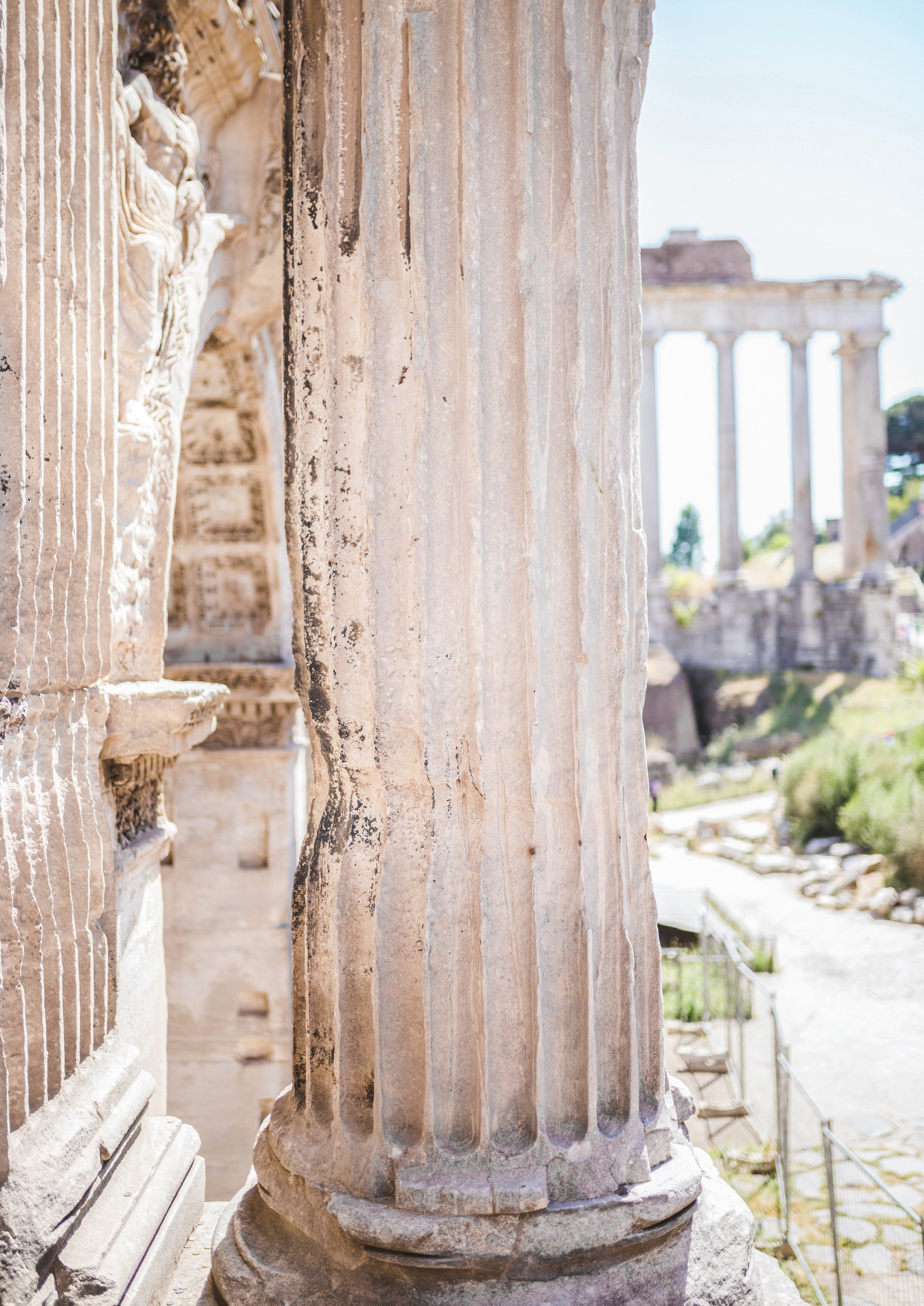*All in the Details is a recurring post we make in which we examine the architectural, design and artistic details, focusing on a different building or place each time. Subscribe to receive every issue.*
Ahhh, Rome. One of the cultural centers of the world, it seamlessly blends the modern and historical into a unique experience, different from anything else available in Italy (and even Europe in general). If you’re like us, you’ve probably grown up with fantasies of touring the Colosseum [below/left], fueled by stories of Roman mythology and fantastic intellectual & political conquests throughout history. The Roman Empire was one of the largest empires in the history of civilization, and at it’s height held sway over 21% of the world’s population (1). Considering the numerous cultural advancements credited to it (and Italy as a whole), it shouldn’t come as a surprise that the city itself is littered with gorgeous buildings, striking ruins [below/right], and the feeling that everything the mind can conceive is a possible reality.
The Roman Forum
This is the area of Rome one visualize’s when they think of the Ancient Romans. The flamboyant center of their ultra-rich empire, it was once a collection of buzzing public spaces and opulent temples. Picture it: the center of the political, philosophical and artistic world, with great scholars chatting about current events, little boys sparring with wooden swords playing ‘conquer Troy’, vendors selling loaves of bread and yesterday’s catch. Now, it’s a slightly-confusing collection of ruins that house some of Ancient Rome’s most famous buildings (below). It was under-appreciated and ill-kept as Rome’s metropolis continued to expand outward, being scavenged for marble, plundered, and even used as a cow pasture for a little while (3).
The Forum is one of the more visited sites in Rome, partially due to it’s historical importance, and partially due to location: it’s conveniently tucked between the Colosseum (below) and Piazza Venezia (first photo above). Because of this, you will almost certainly be bombarded with peddlers, so be aware. It’s not hard to dodge them though, since so many people are around, but if you do find yourself having to deny that you’re interested in buying some cheap souvenir, be firm and continue moving. It behooves you to keep moving in this area of the city anyway, because there’s so much to see.
Vatican City
One of Rome’s biggest attractions is Vatican City, the centre of the Catholic religion. Technically it’s own sovereign city-state, Vatican City and it’s surrounding areas contain some of the richest cultural and and religious history available anywhere in the world. It’s also recognized as Earth’s smallest independent state in both size and population. The population of Vatican City is around 800 people (something like 450 have actual Vatican citizenship) while the rest have permission to live within it’s borders without the benefits of being a citizen (2).
When it comes to Vatican City, it's pretty difficult to know where to begin. There's St. Peter's Basilica (the "Holiest Church in the Kingdom") and the famous St. Peter's Square in front of it, the Vatican Museum and Library, the expansive Gardens, the Sistine Chapel, and much more. Definitely carve out nearly an entire day to explore everything it has to offer; but be warned: you will be met with flocks of tourists, just like yourself, eager to uncover something about the artists that built it.
There are ways to get around the biggest issue when visiting the Vatican Museum: the line to get in. On just about any day within a month of Rome's tourist high-season, you can expect to wait nearly four hours to get into the Museum. That is, unless you purchase a ticket online that allows you to skip the lines. This is absolutely worth the extra fee (which is fairly nominal), and you aren't bound to any slow, boring group tour. You literally get to skip the line (and the sun), then go on your own journey. This won't save you from the crowds INSIDE the museum's long, winding exhibits, but it'll get you through the front door without having to brave the Italian sun for hours. Click here to see our favorite way to do this.
The lush green of the Vatican Gardens
Once inside you'll be met almost immediately with the Vatican's lush garden courtyards. An array of greenery flourishes in the Mediterranean Roman climate, and the sprawling gardens now take up a whopping 57 acres. It's not just flora either; there are a wide array of artistic and architectural additions, including Renaissance fountains, monuments and statues, and the Torre San Giovanni (Saint John's Tower). Unfortunately the main function of the gardens is for the Pope's relaxation, so access is limited to paid tours and window views from inside the museum. Clicking this will take you to a couple different options when it comes to a garden tour.
Unless you pay for a tour, your access will be very limited to the gardens. There are always windows open inside the museum though, so keep your eyes peeled!
The Swiss Guard standing watch over a restricted entrance to St. Peter's Basilica.
St. Peter’s Basilica (below/left) is, conservatively, one of the most magnificent cathedrals Europe has to offer. There’ll be a line through some metal detectors to get in, but don’t be deceived: they move quick, and what looks like an unbearable amount of time might just surprise you with it’s swiftness. Once inside there is only one piece of advice worth anything: take your time. There is an insane amount of detail to appreciate, so be prepared to explore every nook and cranny.
Of course, no trip to Vatican City would be complete without going into the Sistine Chapel (below). When visiting the Vatican Museum (inside which the Sistine Chapel is located), you must complete the ENTIRETY of the tour through the museum in order to make it to the Chapel. There will be signs every 300m notifying you of it's direction, but don't be fooled: you can’t simply get there to see it first, then go through the entire museum afterward. The Chapel is the climax of an artistic and cultural narrative, told from ceiling-to-ceiling, so you might as well enjoy the ride along the way (5). To check out other beautiful ceilings inside the Vatican, click here.
Pantheon
Holding the title for most pristinely preserved Ancient Roman building, the Pantheon (below/left) was completed in 125 C.E. during the reign of the little known Hadrian (6). The current Pantheon is the third installment of the building, the first commissioned by Marcus Vipsanius Agrippa (27-25 BCE) and the second by Domitian (51-96 AD). Both earlier versions of the temple were destroyed by fire, the second being struck by lightning. Restorations on the Pantheon began again some time around the reign Trajan (98-117 CE), but did not finish until around 125 CE when Hadrian reigned. The structure of the Pantheon is comprised of a series of intersecting arches, resting on eight piers which support eight round-headed arches. The Pantheon remains the world's largest unreinforced concrete dome, almost 2,000 years after it was completed (7)

















